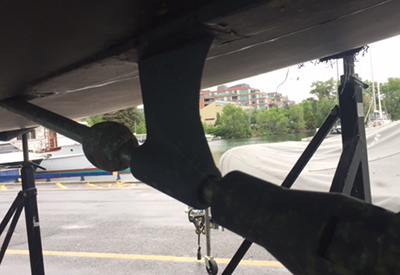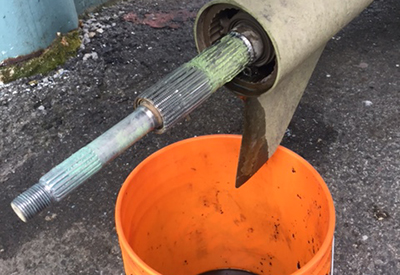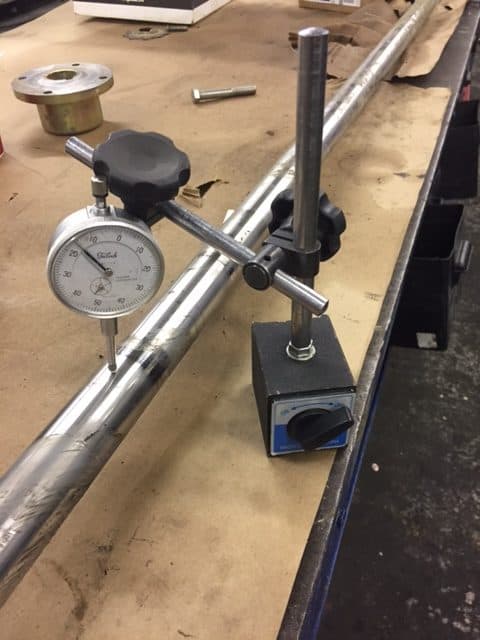Ask Andrew: I Hit Something! Now what?

September 11, 2025
Inspecting the prop, strut, cutlass bearing and shaft anode
The moment we all dread. It’s a warm sunny day and you’re out for a cruise. Suddenly the boat shudders beneath you, pings, dings and clangs are heard and you realize that you’ve hit something submerged.
From a seamanship standpoint – there are many pieces of advice and rules to follow. To put it all succinctly: Get yourself, your crew and your vessel in a position of safety (whatever good seamanship requires), first and foremost. This should, in almost every circumstance, include taking the engine out of gear.
Once your vessel and crew are safe and secured, realization will slowly creep in that damage has been done, and that a repair bill may run high. Before panicking – let’s take a look at some common damage points, what your repair tech will look at to assess the damage, and what you can do on your own to keep your costs down.
Before taking any action when damage has occurred, you should speak with your insurance company. They may direct you to have certain work performed in certain ways (and your coverage may be dependent on following their instructions).

In most cases, when underwater damage occurs, the boat will need to be taken out of the water to assess damage (either trailered, or lifted by a travelift). This should be done as soon as possible after damage. Here’s a quick list of what you should be looking for:
1) Damage to the hull – including fiberglass, metal, wood, through-hull fittings, the bedding of through-hulls and hull anodes

2) Damage to the prop-shaft – some boats have a prop shaft running from the engine directly to the prop, others may have sail-drives or stern-drives. All configurations have a prop shaft that may have been damaged if an object has come in contact with the spinning propeller. Sometimes damage or bending can be seen with the naked eye, other times the shaft may have to a ‘dialed’ – meaning that a tool called a dial indicator is used to measure any bending in the shaft
3) Damage to the strut and cutlass bearing – on boats with a long shaft, a strut assists in supporting the weight of the shaft extending outward from the hull. The shaft runs through a cutlass bearing (mounted inside the strut) which absorbs heat caused by friction, as well as preventing the shaft from wobbling as it turns at high RPM. If the prop has impacted, causing the shaft to bend, the chances are high that the cutlass bearing may also be damaged, as well as the strut supporting the shaft
4) Sail-drive and stern-drive gears: In situations where the propeller impacts an object on a vessel with a sail or stern drive, the prop shaft may be damaged or bent. Inside the drive units, the shafts are driven by a series of gears, encased in gear oil. In a situation where an impact has occurred, the gear oil should be drained into a clean pan, and inspected for evidence of metal filings which would indicate damage to the gears inside the drives. If particles are found, and the gear lube is darkened or smells burned, the drive unit should be broken down and rebuilt as necessary.
5) Engine couplers – the component that joins the engine to the propeller shaft is called the engine coupler. In a heavy impact, the shaft could be thrown so far out of true that the coupler is damaged in turn – which could also cause damage to the engine. The shaft should be removed from the coupler and both inspected/replaced if any damage is suspected
6) Speedometers and transducers should be inspected for damage and tested before relaunching. Speedometers can be blown with compressed air (causing the gauge at the helm to ‘jump) which confirms proper functionality
7) Trim Tabs – trim tabs work via hydraulics – the tabs themselves, as well as the hydraulic arms and fluid reservoirs should be visually inspected, and the entire system tested before relaunching
8) Propellers, Skegs and Anodes – Damaged props should be removed and refurbished by a repair shop. Propellers that aren’t in balance can cause damage to shafts and engine couplers (and on a secondary note can cause poor engine performance and lack of fuel efficiency). Broken or bent skegs should be repaired and anodes replaced if cracked or lost.
It’s scary to think of underwater damage and the risks that go along with boating – understanding and being prepared are the best tools that we have for preventing damage before it occurs.
Safe boating everyone!
Andrew McDonald

Andrew McDonald is the owner of Lakeside Marine Services – a boat repair/maintenance firm based in Toronto. Andrew has worked in the marine industry for 12 years and is a graduate of the Georgian College ‘Mechanical Techniques – Marine Engine Mechanic’ program. Questions or comments for Andrew? Email him directly via: info@lakesidemarineservices.ca




























